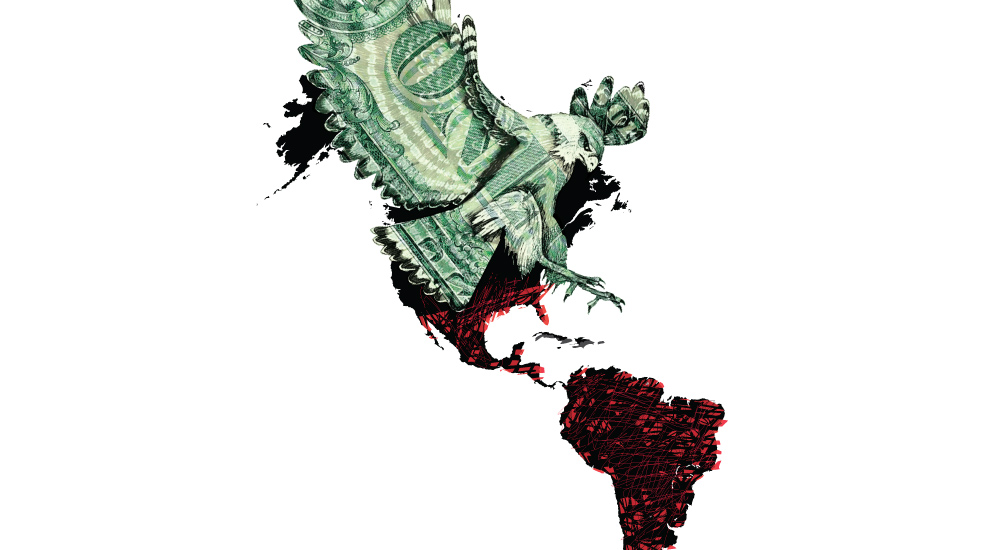Image: Ideas de Izquierda
This article originally appeared in in Ideas de Izquierda, (IdZ) #28, April 2016.
Dhaka, April 24, 2013. On that day, the capital of Bangladesh hit the headlines around the world after the collapse of Rana Plaza, a monstrous eight-story building that housed several textile factories, a bank, and a few shops. It was one of the worst disasters ever seen in a workplace, causing the tragic death of 1,133 garment workers and injury of another 2,500.
This crime is the starting point of the recently-published Imperialism in the Twenty-First Century: Globalization, Super-Exploitation, and Capitalism’s Final Crisis,1 in which John Smith presents the key pillars on which the current world capitalist system rests.
The collapse of Rana Plaza reminds us of the persistence of the current practices of brutal exploitation and blatant negligence mirroring human degradation witnessed in the 19th century. It also leads us directly to one of the central ideas of the book: that the workforce of the so-called “Global South” is a focal point in the valorization of capital–making regarding it as something peripheral a thing of the past. This is clearly illustrated by the author, who goes so far as to suggest that the “capital-labor relation has become a relation between northern capital and southern labor” (p. 12).2
The Global Commodity
This book illuminates and analyzes aspects of the configuration adopted by internationalized production from a Marxist perspective. The author explores how relations of production have been transformed by the development of what he defines as the “global commodity.”
He describes this concept as “the result of the choreography of an immense diversity of concrete labors of workers in five continents” (p. 27). Textiles, cellular phones, and even Nespresso capsules are some of the examples Smith uses to illustrate the breadth of this phenomenon.
If there is anything that has defined capitalism of the last several decades, it is outsourcing, the relocation of production carried out by the largest companies of the wealthiest capitalist economies. For Smith, the driving force behind this trend is no secret–what has motivated capital to move towards productive globalization is a process known as labor arbitrage.
Smith uses this term (first coined by Stephen Roach, former head of Morgan Stanley Asia) to refer to capitalism´s quest to maximize the possibilities of wage expenditure reduction. Since the 1980s, relocation has made its first target the production processes of commodities characterized as labor-intensive. This leads to the separation of the production process into many component processes, each carried out autonomously by separate production units thousands of miles apart.
The globalization of production through relocation is a much-analyzed topic, especially in the new millennium. But less common until quite recently has been distinguishing the various ways in which this restructuring of production has occurred.
These changes are commonly associated with the foreign direct investment (FDI) of transnational corporations (TNCs). Most TNCs are situated in imperialist countries and a great proportion of their total FDI is in the Global South. Smith defines the process by which TNCs replaced factories in developed nations–through investment in their own factories in other poor and developing countries as “internal” relocation. He then highlights a second form of relocation which has gained prominence–what he defines as arm’s length relationships between TNCs and their suppliers; the relationship between Apple and FoxConn being an example of this. Unlike cases of “internal” outsourcing, there is no established property relationship between the firms. However, this does not mean Apple has less control over the conditions in which FoxConn manufactures its goods, nor does the supplier have one iota more autonomy than a subsidiary.
The expansion of TNCs through arm’s length outsourcing has increasingly gained in importance. Smith quotes William Milberg, a scholar of global value chains (GVCs): “[D]espite the stunning increase in the transnational activity of large firms … such firms find it increasingly desirable to outsource internationally in an arm’s length rather than non-arm’s length (intra-firm) relation.”3
Smith illustrates this through an examination of the evolution of bilateral trade between China and the United States. He compares the development of intra-firm imports to the U.S. (the growth of which serves as an indication of growth in internal outsourcing) with purchases from “independent” suppliers. Between 1992 and 2005, the growth of imports was exponential, going from $3 billion to $63 billion, an increase of over 20 times. In the same period, TNC imports from independent suppliers rose from $22 billion to $180 billion. While these grew (only) ninefold, in 2005 they accounted for three times the amount of intra-firm trade (p. 80).
Despite these figures, Smith suggests that “analysts [tended] to see globalization through a foreign direct investment lens” right up until the first decade of the 21st century.4 This is also true of the overwhelming majority of Marxist analyses of contemporary imperialism. Imperialism in the Twenty-First Century aims to define the implications of the development of global value chains (GVCs) commanded by the TNCs through these arm’s length suppliers. One aspect that defies intuition is that the a priori substitution of internal relocation for arm’s length suppliers means that TNCs forego the appropriation of surplus value allowed by the exploitation of labor through subsidiaries. Since TNCs do not own arm’s length suppliers, they do not receive the profits from industry that they would from subsidiaries in the case of internal relocation. Returning to Milberg, Smith states that the preference for such outsourcing must mean that the returns generated by external relocation–by cost reduction brought by purchasing from these firms–must exceed those of vertical operations.5 These cost savings “constitute rents accruing abroad in the same sense that internal profit generation does for a multinational enterprise.”6
Smith offers a number of reasons why arm’s length outsourcing is preferable to foreign direct investment, from capital´s perspective. One aspect of this is that, citing Martin Wolf of the Financial Times, “Transnational companies pay more–and treat their workers better–than local companies do” (p. 80-1). A second incentive is that such a relationship with an independent supplier keeps TNCs’ “hands clean”: the TNC externalizes the commercial risk, low value-added production processes and direct responsibility (p. 81). Third, through this relationship, TNCs can avoid many of the costs and risks linked to fluctuations in demand or severe disruptions in world markets, as seen in 2008-09. The TNC suppliers are now responsible, should the need for mass redundancies in times of crisis arise. Finally, though the arm’s length relationship does not generate flows of repatriated profits, it does not require the allocation of funds for the establishment of subsidiaries, thus freeing up the resources of firms, which can then be devoted to “financial intermediation and speculation” (p. 82).
The study of the relocation of production and the importance of the “global arbitrage” of labor power highlights how capital´s global expansion of capital contributes to countering the falling profit rates of the 1970s: Smith affirms, “Outsourcing supported the rate of profit in imperialist countries” and has “become an increasingly favored alternative to investments in new productivity-enhancing and capacity-expanding technology, enabling operating profits to be diverted from investment in plants, machinery, and living labor into financial speculation of different kinds” (p. 298).
This explanation provides us with the necessary elements to understand the slowdown of growth in imperialist economies over recent decades, and suggests a close connection between financialization and relocation–key to understanding the complex landscape of global capitalist crisis today.
Super-exploitation?
Imperialism in the Twenty-First Century attempts to explain the appropriation of surplus value by the richest nations of contemporary capitalism on the basis of the Marxist theory of value. Smith takes as his starting point the debates of the 1960s and 70s around dependency theory, which he sees as “the first and last sustained attempt to found the theory of imperialism on Marx’s theory of value” and which “remains a crucial reference point for contemporary study of imperialism” (p. 206).
Smith´s study aims to land a punch to the glass jaw of what has alternately been defined as Euro-Marxism or the Marxist critics of dependency theory (all of them labeled as “orthodox” Marxists without further explanation). Smith polemicizes authors like David Harvey, Robert Brenner, Ellen Meiksins Wood and John Weeks, who downplay the importance of the plundering of the Global South, and in particular what Smith describes as “the super-exploitation of labor power.”
He puts forward the concept that this super-exploitation reveals the existence of a third form of surplus value increase. Remember that in Capital, Marx defined two ways in which the capitalist class can increase the surplus value appropriated by the exploitation of labor power. The first occurs by the lengthening of the working day–what Marx defined as absolute surplus value. This extends the amount of time during which labor power generates surplus value that is wholly appropriated by the capitalists. The second way of increasing surplus value consists of reducing necessary labor time, that is, the value of labor power. This, defined by Marx as relative surplus value, is done by reducing the amount of labor time needed to produce the commodities that go into the pool of goods consumed by workers, thus making the contents of said pool cheaper. In this way, the wage outlay that the capitalists need in order to pay for this necessary labor time falls, while the labor force sees no decrease in its access to these goods. The result is that a smaller portion of the working day is required for capital to replenish the equivalent of what has been paid in wages, and the amount of surplus labor time during which capital can appropriate surplus value is increased.
Smith proposes the existence of a third form. This consists in the reduction of wages below the value of labor-power. Andy Higginbottom, who originally developed the idea of The Third Form of Surplus Value Increase, argues: “The idea of super-exploitation needs to be conceptually generalized at the necessary level of abstraction and incorporated in the theory of imperialism. Super-exploitation is a specific condition within the capitalist mode of production… the hidden common essence defining imperialism.”7
The “generalization” of the idea of super-exploitation proposed by Smith (with Higginbottom as its source) raises a number of questions. Although Marx recognized super-exploitation as an occasional phenomenon, there are reasons he did not generalize it as Smith and Higginbottom do. First, it is arguable that super-exploitation can exist as a permanent situation–as something differentiated from “normal” exploitation. Smith rejects the claim made by neoclassical theory that the lower wages of workers in peripheral countries are explained by lower marginal productivity. In his opinion, the lower wages of workers in these countries are not explained by either lower productivity or the “relative scarcity” of capital with respect to the allocation of work in less developed economies (another argument used by mainstream neoclassical theory to account for this imbalance). What is behind the gap in salary levels between developed and poorer countries–a gap that, contrary to ideas in mainstream theory, has not diminished but is increasing in terms of the purchasing power of wages–the basic asymmetry that characterizes the global economy; that is, while capital can move unhindered around the globe, the mobility of labor power is severely restricted. Barriers to the migration of workers from poorer countries are glaring evidence of this. However, the objection to the neoclassical approach and the role played by obstacles to the mobility of labor in maintaining wage differentials do not demonstrate that labor power is being paid anything less than its value in the dependent and semi-colonial economies. It only shows that the value is lower in these countries.
This is connected to one of the book’s most critical arguments related to the production of value and surplus value. Smith repeatedly affirms that it is necessary to separate the question of productivity from the rate of exploitation (defined as the ratio between surplus and necessary labor times). In his opinion, the rate of exploitation is not increased by the higher productivity of developed economies, whereas it is indeed increased in poorer economies by depressing wages to levels below the value of their labor power. By minimizing the roles of the differences in productivity between these economies, their differing capacities for the generation of value and above all, their different rates of exploitation, Smith ends up exaggerating the reach of what he defines as super-exploitation. The productivity gap which characterizes dependent economies from imperialist economies signifies a reduced capacity for dependent economies to generate the same value as that of imperialist economies for the same outlay. In an international comparison, an hour of work in a less developed economy is equal to less than an hour in an imperialist economy (in terms of value generation). This is related to wage levels, not because of the application of the neoclassical criteria of marginal productivity, but because a decrease in wages is just one way to compensate for this lower productivity.
Smith criticizes Marxists who argue that the higher productivity of the richest economies may involve greater exploitation, but his claims–that to analyze in depth requires more breaks from the theory of value–are no more satisfactory.
The grand-scale exploitation of the cheapest labor force through arbitrage has, of course, allowed capital to increase the appropriation of surplus. But once we consider differentials in productivity, we can see that in terms of appropriation of surplus, this phenomenon has not extended as far as the author claims.
Finally, to speak of a prolonged period of so-called “super-exploitation” as Higginbottom proposes, and to generalize this at the level of absolute and relative surplus value is a bit of a stretch. If wages fall below their presumed value in a particular area over a prolonged period of time, this would actually be an indication that capital has managed to impose a much lower value on labor power in that country. This would then lead to a higher rate of exploitation, which would no longer fit the definition of super-exploitation.
Final considerations
Imperialism in the Twenty-First Century has the merit of opening new dimensions in the Marxist theorization of modern-day capitalism. The question of global labor arbitrage was incorporated into various analyses some time ago.8 But to theoretically disconnect this concept from the basis of Marxist theory by incorporating all the implications of what has been generated by value chains through various forms of outsourcing has until now been an open-ended question. This book is a step forward in this regard and provides an important piece of the puzzle of value-generation in the global economy, a concept which several Marxist authors have elaborated. Smith’s analysis is sharp and polemic.
Although the author’s starting point is the “global commodity,” the repeated posing of the question in terms of a North-South opposition seems to shift the analysis away from a class analysis. By failing to consistently maintain the class perspective with which he begins, at times he shifts into posing an opposition in national terms. This is one shortcoming that limits the contributions of this work.
Despite these limitations, the book’s presentation of the differentiations in the global labor force, how they operate and are taken advantage of, as well as how capital and nation-states act to preserve the conditions to perpetuate it, are elements fundamental to an understanding of imperialism in the 21st century.
Footnotes:
1. Imperialism in the Twenty-First Century: Globalization, Super-Exploitation, and Capitalism’s Final Crisis, New York, Monthly Review Press, 2016.
2. Page numbers for all quotes are indicated in the body of the text in parentheses.
3. William Milberg, “The changing structure of international trade linked to global production systems: what are the policy implications?”, Working Paper No. 33, Policy Integration Department, World Commission on the Social Dimension of Globalization, International Labor Office, Geneva, 2004.
4. Ibid.
5. Ibid.
6. Ibid.
7. Andy Higginbottom, 2011, “The System of Accumulation in South Africa: Theories of Imperialism and Capital”, Économies et Sociétés, 45/2 (2011), p. 268.
8. See for example Juan Chingo, “Crisis y contradicciones del ‘capitalismo del siglo XXI’” (“Crisis and Contradictions of ‘Capitalism of the 21st Century’”), Estrategia Internacional (International Strategy) 24, December 2007.
Translation: Sean Robertson











